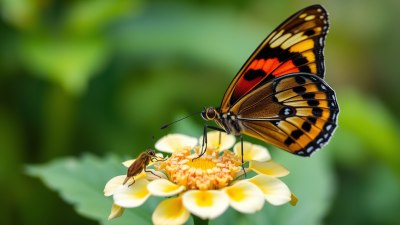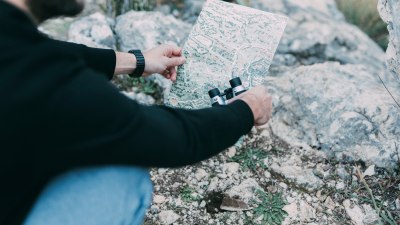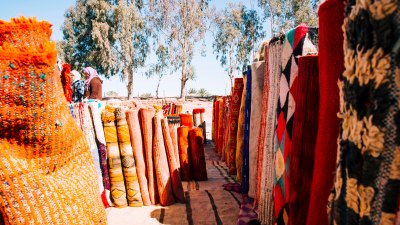Learning to Identify Local Insects and Butterflies on Safaris
Discover how to identify insects and butterflies during safaris for a deeper wildlife experience.

Image created with Flux Schnell
Embarking on a safari is often associated with observing majestic animals like lions, elephants, and giraffes. However, the intricate world of insects and butterflies is equally fascinating yet frequently overlooked. Learning to identify these creatures can enrich your safari experience, offering insight into the ecosystem and the roles these small but vital organisms play.
Insects are incredibly diverse, with more than a million described species and many more yet to be discovered. They inhabit every corner of the earth, and their presence in a safari environment is an indication of a healthy ecosystem. Butterflies, often seen fluttering around flowers, are particularly captivating due to their brilliant colors and delicate nature. Understanding how to identify local insects and butterflies not only enhances your appreciation of the wildlife but also gives you a glimpse into the complex interdependencies within nature.
The Importance of Insects in Ecosystems
Insects play numerous essential roles in ecosystems, including pollination, decomposition, and being a food source for other animals. For example, bees, beetles, and butterflies are significant pollinators that help plants produce fruits, seeds, and new plants, maintaining biodiversity. Decomposers like ants and termites break down organic material, returning nutrients to the soil, thus supporting plant life. Additionally, insects are an integral part of the food chain, serving as prey for birds, mammals, amphibians, and reptiles.
How to Start Identifying Insects and Butterflies
When trying to identify local insects and butterflies, the key is observation. Start by paying attention to where you find these creatures, their behaviors, and characteristics. Here are some steps to guide you:
- Choose the Right Time: Early morning or late afternoon are prime times for insect activity, especially butterflies. Heat can drive them to seek shade, reducing sightings.
- Know Your Location: Research the types of habitats on your safari route. Different insects thrive in specific environments, such as wetlands, forests, or grasslands.
- Observe and Record: Bring a notebook or use a smartphone app to take notes on your observations, including size, color, and behavior.
- Learn Key Features: Familiarize yourself with basic entomology terms and features like wings, antennae, and body segments to help with identification.
Common Insects and Butterflies to Look For
While every region has its unique fauna, certain insects and butterflies are frequently encountered during safaris. Below is a list of some common species you might encounter:
Butterflies
- Common Buckeye (Junonia coenia): This butterfly is recognizable by its striking eyespots on its wings, which can deter predators.
- Monarch Butterfly (Danaus plexippus): Famous for its orange and black wings, the Monarch is known for its long migratory patterns.
- Painted Lady (Vanessa cardui): This butterfly is one of the most widespread in the world, known for its vibrant colors and adaptability across various climates.
Common Insects
- Painted Lady Caterpillar: Before becoming a butterfly, the caterpillar stage of the Painted Lady can often be found munching on a variety of plants.
- Ants: With myriad species and colors, ants can be spotted foraging for food, forming distinct trails, and even engaging in fascinating group behaviors.
- Termites: Often mistaken for ants, termites are vital decomposers that build intricate mounds, which can be seen across various safari terrains.
Utilizing Resources for Identification
Many resources can assist you in identifying local insects and butterflies. Here are some useful tools:
- Field Guides: Invest in a regional field guide that includes photos and descriptions of the insects and butterflies specific to the area you are exploring.
- Mobile Apps: There are numerous mobile apps designed for identifying insects. Some allow you to upload a photo and provide instant identification.
- Local Experts: If you are on a guided safari, don’t hesitate to ask your guide about local insects and butterflies. Their knowledge can provide invaluable insights and tips.
Engaging with Nature
Drawing attention to insects and butterflies invites a different perspective on nature. As you search for these creatures, notice the plants they depend on. Many butterflies need specific host plants for their larvae, and adult butterflies often rely on nectar-rich flowers. This creates a unique opportunity to learn about plant-insect interactions and the health of ecosystems.
Safeguarding Local Insects and Butterflies
With increasing threats from habitat loss, climate change, and pollution, protecting local insects and butterflies has become a critical concern. Supporting conservation efforts and being mindful of environmental practices can help maintain the biodiversity of ecosystems. Here are some simple steps you can take:
- Follow “Leave No Trace” Principles: When on a safari, be respectful of wildlife habitats. Avoid disturbing plants and insects.
- Support Local Conservation Organizations: Participate in or donate to groups dedicated to preserving the local environment and its inhabitants.
- Educate Others: Share your knowledge and experiences with others to raise awareness about the importance of insects and butterflies in ecosystems.
While large mammals often steal the spotlight during a safari, the hidden wonders of insects and butterflies enrich your wildlife experience. Learning to identify these creatures fosters a deeper connection to the environment and showcases the intricate balance that sustains life. As you venture forth on your safari adventures, remember to take stock of the smaller yet equally vital beings that roam the land. Embrace the thrill of discovery as you explore the enchanting world of local insects and butterflies.











